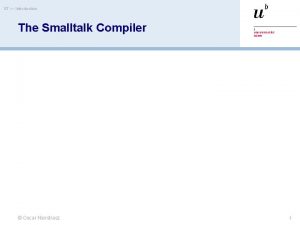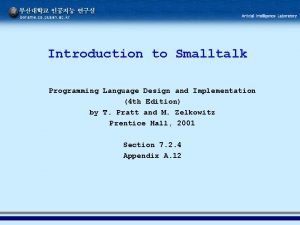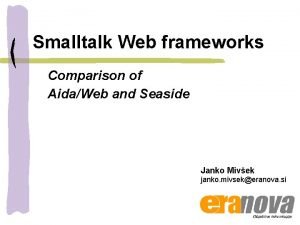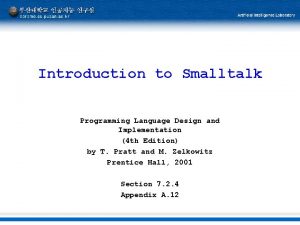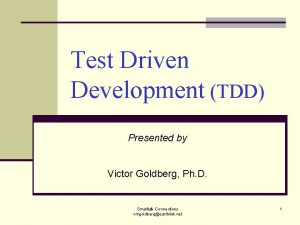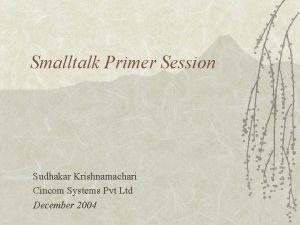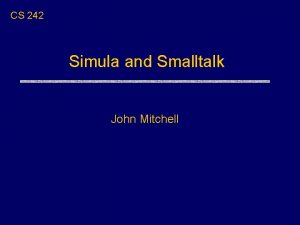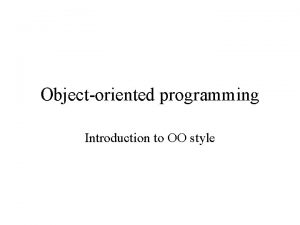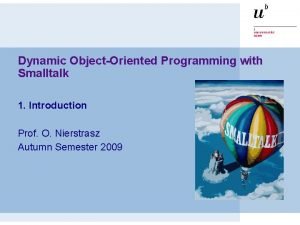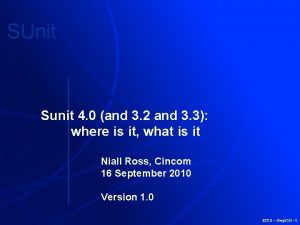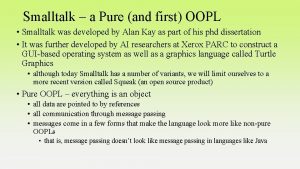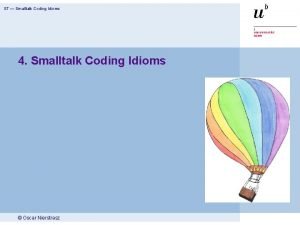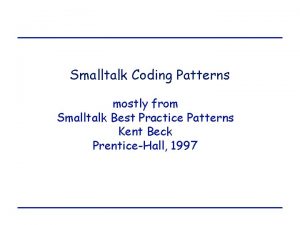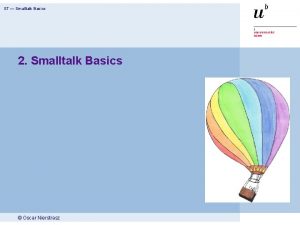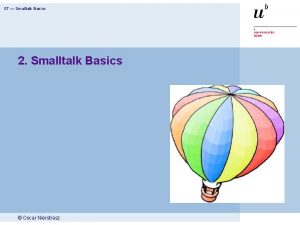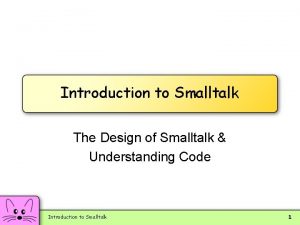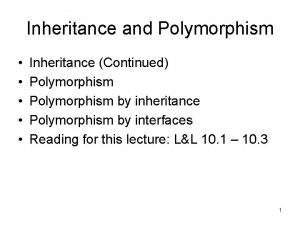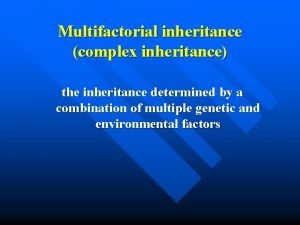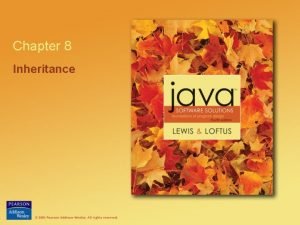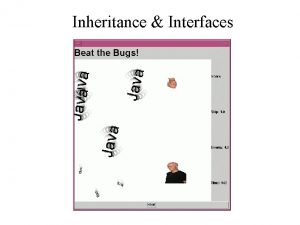The Smalltalk Environment SUnit and Inheritance 1 Names



















- Slides: 19

The Smalltalk Environment, SUnit, and Inheritance 1

Names • Capitalization conventions ‣ local variables start with a lower-case letter ‣ non-locals start with an upper-case letter ‣ new words are capitalized ° pariwise + product => pairwise. Product ° with + all + subclasses => with. All. Subclasses 2

Naming Guidelines • Name methods after what they accomplish ‣ … not after the mechanism used in the implementation ‣ imagine a very different implementation. ° • could you name this imagined method the same? Use the same name as the method in the other class that does a similar thing 3

Naming Guidelines • Name variables after their roles ‣ instance variables and temporary variables should be named after their role sum result bounds ‣ don’t add a temporary variables unless there is a reason to do so! b : = self bounds. children do: [ : each | … b top. Left … b bottom. Right …] 4

5

6

7

8

Interfaces of the Collections Abstract class

10

11

What about Parsing Numerals? • Where should the methods go in the class hierarchy? parse. As. Numeral digit. Value reversed paired. With. Powers. Of 10 pairwise. Product sum 12

Unit Testing • Code that isn’t tested doesn’t work ‣ Well, it’s true of my code — with the exception of simple accessors • Two kinds of testing ‣ Unit testing ‣ Functional testing 13

What are test for? • Tests are an executable specification of the functionality that they cover - always synchronized with the code • Tests increase the likelihood that the code is correct. - When you introduce a bug, you are more likely to find it very quickly, while it is still easy to fix • Writing “tests first” improves your interfaces - you see your code from the client’s point of view • The presence of tests gives you the courage to make structural changes to the code: refactoring - refactoring is essential to prevent creeping entropy 14

Test-driven Development • When creating fresh code: ‣ First write a test ° • only then write the code that makes the test run When maintaining old code ‣ First write a (failing) test to isolate the bug ° then fix the bug ° … and run the whole test suite 15

A problem due to Hamming From Dijkstra's A Discipline of Programming. Problem: construct an ordered set such that: A 1. 1 is in the set A 2. if x is in the Set, then x*2, x*3 and x*5 are in the set. A 3. there are no other values in the set. Dijkstra limits himself to a proper prefix 16

Dijkstra’s Solution Transcribed into Smalltalk, and parameterized by n: dijkstras. Solution: n "This is a Smalltalk translation of Edsger Dijkstra's solution to Hamming's problem, as presented in chapter 17 of 'A Discipline of Programming'. P 0 means that aq represents the first (aq size) elements of the sequence. P 1 means that (x 2 is the minumum value > aq last s. t. x 2 = 2 * x for some x in aq) and (x 3 is the minumum value > aq last s. t. x 3 = 3 * x for some x in aq) and (x 5 is the minumum value > aq last s. t. x 5 = 5 * x for some x in aq) The the loop termination test has been moved to the middle of the loop to make it possible to generate the sub-sequence of element <= n " | i 2 i 3 i 5 x 2 x 3 x 5 aq next. Element | n is. Integer if. False: [self notify: 'dijkstra. Solution: argument ', n print. String, ' must be an integer. ']. aq : = Ordered. Collection with: 1. i 2 : = i 3 : = i 5 : = 1. x 2 : = 2. x 3 : = 3. x 5 : = 5. “{ P 1 established }” 17

Dijkstra’s Solution "{ P 1 established }" [next. Element : = (x 2 <= x 3 and: [x 2 <= x 5]) if. True: [x 2] if. False: [ (x 3 <= x 2 and: [x 3 <= x 5]) if. True: [x 3] if. False: [ (x 5 <= x 2 and: [x 5 <= x 3]) if. True: [x 5]]]. next. Element > n if. True: [^aq as. Array]. aq add. Last: next. Element. "{aq size has been increased by 1 under the invariance of P 0}" [x 2 <= aq last] while. True: [i 2 : = i 2 + 1. x 2 : = 2 * (aq at: i 2)]. [x 3 <= aq last] while. True: [i 3 : = i 3 + 1. x 3 : = 3 * (aq at: i 3)]. [x 5 <= aq last] while. True: [i 5 : = i 5 + 1. x 5 : = 5 * (aq at: i 5)]] repeat 18

How to solve this without being brilliant? • • Generalize from the given problem We start with a set, and add new elements: ‣ based on the existing contents of the set ° if x is already in the set add x*2, x*3, … ° if x and y are in the set, add x ∪ y ‣ subject to some condition (x < 100) 19
 Sma compiler
Sma compiler Smalltalk implementations
Smalltalk implementations Themen smalltalk
Themen smalltalk Seaside smalltalk
Seaside smalltalk Smalltalk history
Smalltalk history Andreas hiltner
Andreas hiltner Smalltalk web framework
Smalltalk web framework Small talk programming language examples
Small talk programming language examples Visual age smalltalk
Visual age smalltalk Smalltalk
Smalltalk Dynamic xxx
Dynamic xxx Smalltalk
Smalltalk Seaside holidays then and now
Seaside holidays then and now Smalltalk seaside
Smalltalk seaside Modern smalltalk
Modern smalltalk Oo style
Oo style Modern smalltalk
Modern smalltalk Squeak tutorial
Squeak tutorial Financial environment of business
Financial environment of business Hát kết hợp bộ gõ cơ thể
Hát kết hợp bộ gõ cơ thể
